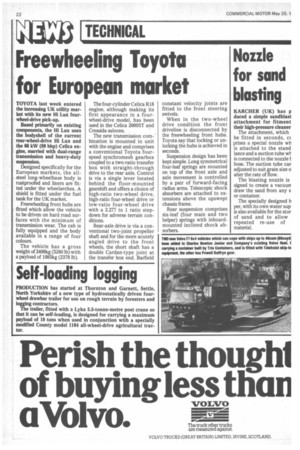Freewheeling Toyota for European market
Page 24

If you've noticed an error in this article please click here to report it so we can fix it.
TOYOTA last week entered the increasing UK utility market with its new Hi Lux fourwheel-drive pick-up.
Based primarily on existing components, the Hi Lux uses the bodyshell of the current rear-wheel-drive Hi Lux and the 66 kW (89 bhp) Celica engine, married with dual-range transmission and heavy-duty suspension.
Designed specifically for the European markets, the allsteel long-wheelbase body is rustproofed and liners are fitted under the wheelarches. A shield is fitted under the fuel tank for the UK market.
Freewheeling front hubs are fitted which allow the vehicle to be driven on hard road surfaces with the minimum of transmission wear. The cab is fully equipped and the body available in a range of four colours.
The vehicle has a gross weight of 2400kg (5280 lb) with a payload of 1085kg (2378 lb). The four-cylinder Celica R18 engine, although making its first appearance in a fourwheel-drive model, has been used in the Celica 2000ST and Cressida saloons.
The new transmission combination is mounted in unit with the engine and comprises a conventional Toyota fourspeed synchromesh gearbox coupled to a two-ratio transfer box with straight-through drive to the rear axle. Control is via a single lever located behind the floor-mounted gearshift and offers a choice of high-ratio two-wheel drive, high-ratio four-wheel drive or low-ratio four-wheel drive with a 2.277 to 1 ratio stepdown for adverse terrain conditions.
Rear-axle drive is via a conventional two-joint propeller shaft and for the more acutely angled drive to the front wheels, the short shaft has a double Cardan-type joint at the transfer box end. Barfield constant velocity joints are fitted to the front steering swivels.
When in the two-wheel drive condition the front driveline is disconnected by the freewheeling front hubs. Toyota say that locking or unlocking the hubs is achieved in seconds.
Suspension design has been kept simple. Long symmetrical four-leaf springs are mounted on top of the front axle and axle movement is controlled by a pair of forward-facing radius arms. Telescopic shock absorbers are attached to extensions above the upswept chassis frame.
Rear suspension comprises six-leaf (four main and two helper) springs with inboardmounted inclined shock absorbers.




























































































































